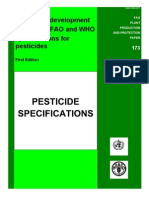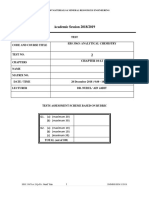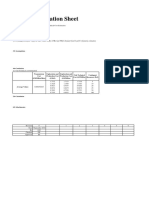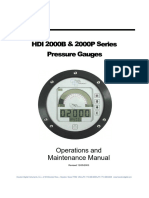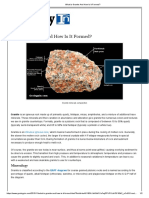Alkyl Polyglycoside
Alkyl Polyglycoside
Uploaded by
PrashantSoniCopyright:
Available Formats
Alkyl Polyglycoside
Alkyl Polyglycoside
Uploaded by
PrashantSoniOriginal Description:
Copyright
Available Formats
Share this document
Did you find this document useful?
Is this content inappropriate?
Copyright:
Available Formats
Alkyl Polyglycoside
Alkyl Polyglycoside
Uploaded by
PrashantSoniCopyright:
Available Formats
ALKYL POLYGLYCOSIDE
PRASHANT SONI
12 OIL 1005
Introduction
Alkyl polyglycosides are non ionic
surfactants
These are basically acetal products
from the reaction of alcohols and
saccharides (which contain a
aldehyde functionality) .
They have superior chemical
properties than other non-ionic
surfactants due to their chemical
structure (strong hydrophilic part:
glucose residue, strong
hydrophobic part: fatty alcohol
residue).
Chemistry of reaction
In synthesis of polyglycosides, a polyfunctional sugar component is
combined with a nucleophile such as an alcohol, carbohydrate etc.
The reaction involves an Sn2 substitution at anomeric carbon stereo
selectively with inversion of configuration.
Raw materials
1) fatty alcohols
Fatty alcohol blends are used to build up the hydrophobic part of the
molecule.
Fatty alcohols can be derived either from the petrochemical (synthetic
sources) or renewable sources (fats and oils)
Fatty alcohol blends used are c12/14 and c16/18 range .
Raw materials
2) Carbohydrate source
The hydrophilic part of the molecule is derived from a carbohydrate .
Both Polymeric and monomeric carbohydrates are suitable as raw
materials.
Polymeric carbohydrates include starch or glucose syrups while
monomeric carbohydrates include water free glucose, glucose
monohydrate (dextrose)
Synthesis
2 methods of synthesis are :
1)Direct process
2)Trans - acetalization process
in either case reaction can be done out in batches or continuously
Direct process
In this process carbohydrate reacts directly with fatty alcohol to form
required long chain alkyl polyglycosides.
In the direct synthesis, monomeric solid glucose types are used as fine
particles. (Carbohydrate is usually dried to remove the crystal- water). It
minimizes the side reactions to take place.
Highly degraded glucose syrup (DE>96) are used to react in such
process.
Sometimes, second solvents are used for providing a stable fine- droplet
dispersion between alcohol and glucose syrup.
This process is simpler from equipment point of view (since single stage
process).
Transcetalization process
It is a 2-stage process.
In first stage, carbohydrate reacts with a short-chain alcohol (n-butanol
or propylene glycol).
In second stage, short chain alkyl glycoside is trans-acetalized with a
long chain alcohol (C12-C18) to form required alkyl polyglycoside.
Industrial production
For production of alkyl polyglycosides based on fischer synthesis are
determined by type of the carbohydrate types used and by the chain length
of the alcohol used.
Low reaction temperatures (< 100 C) in the acetalization lead to alkyl
polyglycosides low in secondary products.
However, low temperatures result in relatively long reaction times and low
specific reactor efficiencies.
Relatively high reaction temperatures (> 100 C, typically 110-120 C) can
lead to changes in color of the carbohydrates.
By removing the lower-boiling reaction products (water in the direct
synthesis, short-chain alcohols in the transacetalization process) from the
reaction mixture, the acetalization equilibrium is shifted to the product side
Typical reaction pressures in the transacetalization and direct synthesis
variants are between 20 and 100 mbar.
Selection of catalyst for glycosidation process is also important.
Acetalization or transacetalization in the Fischer synthesis is catalyzed
by acids
Acids with sufficient strength suitable for this purpose are sulfuric acid,
para-toluene- and alkylbenzene sulfonic acid and sulfo succinic acid.
The reaction rate is dependent on the acidity and the concentration of
the acid in the alcohol.
Flow diagram for industrial
production
Industrial scale glycosidation process
Mass balance of product
For 100 kg of product :
Glucose +
We require
dodecanol
1. Glucose : 51.72 kg
2. Dodecanol : 53.44 kg
(Assuming 100% conversion )
dodecyl octyl glycoside
Application of alkyl polyglycosides
Bottle washing
Highly alkaline formulations
Metal Cleaners
Paint strippers
Personal care products
Aluminum brighteners
Glass cleaners
Highly alkaline detergents
Detergents
Industrial manufacturer
HENKEL is major player in production and R&D of alkyl polyglycosides.
Other companies which are offering such surfactants are:
BASF
AKZO NOBEL
SEPPIC
ICI
REFERENCES
Nonionic Surfactants: Alkyl Polyglucosidesedited by Dieter Balzer,
Harald Luders
Alkyl Polyglycosides: Technology, Properties, Applications edited
by Karlheinz Hill, Wolfgang von Rybinski, Gerhard Stoll
http://www.dow.com/surfactants/
You might also like
- Lutensol To SeriesDocument13 pagesLutensol To SeriesQuoc ThanhNo ratings yet
- Dt466-Dt570-Torque de Cabaza ValvuasDocument22 pagesDt466-Dt570-Torque de Cabaza ValvuasWero vences Alpargatas80% (5)
- DEGACRYL Product Range enDocument1 pageDEGACRYL Product Range enslantsyhimNo ratings yet
- Cognis Surfactants PDFDocument27 pagesCognis Surfactants PDFEdin Krdžalić Edo100% (2)
- Fixapret F ECODocument4 pagesFixapret F ECOSajida Hafeez0% (1)
- Hough TonDocument5 pagesHough TonalexfoschecaNo ratings yet
- ECOSURF LiteratureDocument16 pagesECOSURF LiteratureTrev GlasbeyNo ratings yet
- EMEA Catafor Formulation BROCHURE - 2015 Copie 270934Document4 pagesEMEA Catafor Formulation BROCHURE - 2015 Copie 270934Duc NguyenNo ratings yet
- 11962-Encapsulated Citric AcidDocument10 pages11962-Encapsulated Citric AcidantiquekNo ratings yet
- Production of Ethylene GlycolDocument15 pagesProduction of Ethylene Glycolindahazhr100% (6)
- Controlling Inrush Current in High Demanding ApplicationsDocument10 pagesControlling Inrush Current in High Demanding ApplicationsFelipe MederosNo ratings yet
- D151821 0020Document1 pageD151821 0020vuongspkt12007100% (8)
- Alcohols, Higher Aliphatic, SurveyDocument26 pagesAlcohols, Higher Aliphatic, SurveyEmmanuel Chang100% (1)
- Product Data: CompositionDocument4 pagesProduct Data: Compositionsriatul2006No ratings yet
- Lutensol AT Types: Technical InformationDocument8 pagesLutensol AT Types: Technical InformationchinmaydabkeNo ratings yet
- Comparing ZDDP and MoDTCDocument9 pagesComparing ZDDP and MoDTChusinwidjajaNo ratings yet
- Handbook & Selection Guide To Detergents & Detergent RemovalDocument22 pagesHandbook & Selection Guide To Detergents & Detergent RemovalYacineNo ratings yet
- Arcosolv TPNBDocument4 pagesArcosolv TPNBamiller1987No ratings yet
- Cloud and PourDocument22 pagesCloud and PourAbdulmajid OsmanNo ratings yet
- PDS 5443 Easywet 20Document2 pagesPDS 5443 Easywet 20Jose Pinto100% (1)
- SC2042Document4 pagesSC2042A MahmoodNo ratings yet
- LABSADocument3 pagesLABSAKhadija Naz100% (1)
- Textile Auxiliaries Surfactant AuxiliariesDocument43 pagesTextile Auxiliaries Surfactant AuxiliariesVimal GirnaraNo ratings yet
- 3 Annexures: Annexure 1: Production DetailsDocument53 pages3 Annexures: Annexure 1: Production Detailsmarcela walterosNo ratings yet
- Bio Softs 101Document2 pagesBio Softs 101Raymond LevineNo ratings yet
- New Values of The Required Hydrophilic-LipophilicBalance For Oil in Water Emulsions of Solid Fatty Acids and AlcoholsDocument4 pagesNew Values of The Required Hydrophilic-LipophilicBalance For Oil in Water Emulsions of Solid Fatty Acids and AlcoholsRicardo100% (3)
- To Formulate Film Forming Spray Using Quercus Infectoria (Oak Gall) For Wound Healing ActivityDocument32 pagesTo Formulate Film Forming Spray Using Quercus Infectoria (Oak Gall) For Wound Healing ActivityInternational Journal of Innovative Science and Research TechnologyNo ratings yet
- BROCHURE Narrow Range ethoxylated-AKZONOBEL-2016Document21 pagesBROCHURE Narrow Range ethoxylated-AKZONOBEL-2016Francesco RicciNo ratings yet
- Chlorinated TSP - Aditya BirlaDocument2 pagesChlorinated TSP - Aditya Birladjyoti_2No ratings yet
- Eumulgin B-2 PDSDocument2 pagesEumulgin B-2 PDSYap Ming Zhe100% (1)
- Dehydol 100 PDFDocument3 pagesDehydol 100 PDFarguijNo ratings yet
- Sokalan RO 100 - TIDocument2 pagesSokalan RO 100 - TIEugene MakNo ratings yet
- Industrial Project Report On Anti Foaming Agent (Silicone Based) For Distillery, Sugar Industry, Paper PlantDocument2 pagesIndustrial Project Report On Anti Foaming Agent (Silicone Based) For Distillery, Sugar Industry, Paper PlanteiribooksNo ratings yet
- SC2032 PDFDocument4 pagesSC2032 PDFA MahmoodNo ratings yet
- Action 150: Super Polish StripperDocument3 pagesAction 150: Super Polish StripperRahmat NorNo ratings yet
- Jantex Oven & Grill CleanerDocument8 pagesJantex Oven & Grill CleanergingakatomNo ratings yet
- 9251048576Document270 pages9251048576alvaroffcNo ratings yet
- Material Safety Data Sheet: 1. Product and Company IdentificationDocument9 pagesMaterial Safety Data Sheet: 1. Product and Company IdentificationMokshaNo ratings yet
- CRC Interactive Industrial Catalog 08Document80 pagesCRC Interactive Industrial Catalog 08Kiran DuggarajuNo ratings yet
- Catalog - b0022441 Amphitol 24nDocument1 pageCatalog - b0022441 Amphitol 24nRajo AmehNo ratings yet
- Nabakem CleanerDocument29 pagesNabakem Cleanersutrisno00No ratings yet
- Solar Panel Wash Data SheetDocument4 pagesSolar Panel Wash Data Sheetmaito2270No ratings yet
- Disperbyk-106 Disperbyk-107 Disperbyk-108: Wetting and Dispersing Additives For Solvent-Borne and Solvent-Free SystemsDocument2 pagesDisperbyk-106 Disperbyk-107 Disperbyk-108: Wetting and Dispersing Additives For Solvent-Borne and Solvent-Free SystemsLê TiếnNo ratings yet
- Hostapur SAS A Traditional SpecialityDocument44 pagesHostapur SAS A Traditional SpecialityMehmet AydinNo ratings yet
- 5040 Plus PDFDocument3 pages5040 Plus PDFForeverNo ratings yet
- Aepd VOX 1000: Technical Data SheetDocument2 pagesAepd VOX 1000: Technical Data SheetCoco HüniNo ratings yet
- KLEN 2207 Cream CleanerDocument3 pagesKLEN 2207 Cream CleanerSneha Nagaokar100% (1)
- Chemical AnalysisDocument26 pagesChemical AnalysisChetan BholeNo ratings yet
- XIAMETER® OFX-8803 Silicone Fluid PDFDocument3 pagesXIAMETER® OFX-8803 Silicone Fluid PDFPablo Manu Gomez VNo ratings yet
- Power Fresh 16Document3 pagesPower Fresh 16M. Ardi PrediyanaNo ratings yet
- Automotive Primer 1640535188Document1 pageAutomotive Primer 1640535188nanoNo ratings yet
- Weldcool 20080515Document11 pagesWeldcool 20080515Vijo JoseNo ratings yet
- HLB SeriesDocument3 pagesHLB SeriesDownload AppsNo ratings yet
- Emulsion Price List Wef 01-04-2011Document6 pagesEmulsion Price List Wef 01-04-2011Vizag RoadsNo ratings yet
- Arrieta Ethylene GlycolDocument8 pagesArrieta Ethylene GlycolNguyen VietNo ratings yet
- Review 1 GlycerinDocument26 pagesReview 1 GlycerinRuban KumarNo ratings yet
- Acrylic Acid - MohitDocument42 pagesAcrylic Acid - MohitvickuNo ratings yet
- Ethyleneglycol - Methods 2520of 2520production (Quality Specifications)Document5 pagesEthyleneglycol - Methods 2520of 2520production (Quality Specifications)jorgchanNo ratings yet
- ALCOHOLS s3Document11 pagesALCOHOLS s3RehanaNo ratings yet
- 01 Process ReactionDocument10 pages01 Process ReactionJacky WongNo ratings yet
- ALKYLATIONDocument6 pagesALKYLATIONtariq fareedNo ratings yet
- AlcoholDocument123 pagesAlcoholArul Sankaran100% (1)
- Cannizarorxn 120207190937 Phpapp01Document71 pagesCannizarorxn 120207190937 Phpapp01Adrian PINo ratings yet
- CentrifugationDocument15 pagesCentrifugationPrashantSoniNo ratings yet
- AlkylationDocument15 pagesAlkylationPrashantSoniNo ratings yet
- AlkylationDocument15 pagesAlkylationPrashantSoniNo ratings yet
- AntioxidantsDocument14 pagesAntioxidantsPrashantSoni100% (1)
- Raj LubricantsDocument10 pagesRaj LubricantsPrashantSoniNo ratings yet
- Microwave ExtractionDocument12 pagesMicrowave ExtractionPrashantSoniNo ratings yet
- MustardDocument17 pagesMustardPrashantSoniNo ratings yet
- GBPPR 'Zine - Issue #35Document75 pagesGBPPR 'Zine - Issue #35GBPPRNo ratings yet
- Additives or ModifiersDocument3 pagesAdditives or Modifiersberchard0% (1)
- Design and Analysis of RCC Framed Structure (G+5) by Using STAAD - Pro and STAAD - EtcDocument6 pagesDesign and Analysis of RCC Framed Structure (G+5) by Using STAAD - Pro and STAAD - Etcraam100% (1)
- EBS 336 - Tests 2 - Q&A - 2018 PDFDocument4 pagesEBS 336 - Tests 2 - Q&A - 2018 PDFNurul Ain JabitNo ratings yet
- One Dimensional Heat FlowDocument4 pagesOne Dimensional Heat FlowSerial SpyNo ratings yet
- Well Fluids Sample PropertiesDocument12 pagesWell Fluids Sample PropertiesgregNo ratings yet
- Theory of ComputationDocument145 pagesTheory of ComputationM KISHORE,CSE(19-23) Vel Tech, ChennaiNo ratings yet
- Keyence Infrared Temperature Sensors BrochureDocument14 pagesKeyence Infrared Temperature Sensors BrochureAlfin AhsanNo ratings yet
- Pressure Gauge - O&MDocument16 pagesPressure Gauge - O&MMitul PatelNo ratings yet
- Fiitjee: Binomial TheoremDocument7 pagesFiitjee: Binomial TheoremDaksh PanchalNo ratings yet
- Failure Analysis Ti-6al-4v Alloy Pedicle Screw RuptureDocument12 pagesFailure Analysis Ti-6al-4v Alloy Pedicle Screw RupturePaul RosiahNo ratings yet
- 10.1.2 Lab - Troubleshoot OSPFv3Document5 pages10.1.2 Lab - Troubleshoot OSPFv3joseNo ratings yet
- Adobong Labong Recipe: How To Cook Ginataang LabongDocument2 pagesAdobong Labong Recipe: How To Cook Ginataang LabongFranklin Dela CruzNo ratings yet
- Basic Cement ChemistryDocument13 pagesBasic Cement Chemistrydina safiriNo ratings yet
- SandeepDocument11 pagesSandeepDevender GehlawatNo ratings yet
- What Is Granite and How Is It FormedDocument2 pagesWhat Is Granite and How Is It FormedPedro Carlos PicapiedraNo ratings yet
- Measurement of UncertaintyDocument15 pagesMeasurement of UncertaintybuffmomNo ratings yet
- UNIT 3 - Part2Document18 pagesUNIT 3 - Part2mohan inumarthiNo ratings yet
- Tutorial 15Document5 pagesTutorial 15Pace AjjaNo ratings yet
- Iit Jam Physics 2008Document5 pagesIit Jam Physics 2008s_adhyaNo ratings yet
- Bending DesignDocument29 pagesBending DesignmaodcbNo ratings yet
- Scheduling RulesDocument31 pagesScheduling RulesDarshana Mayekar100% (1)
- Security&OpmarkDocument19 pagesSecurity&Opmarksina20795No ratings yet
- Bci101 04 Identify Priority Improvement Areas v1.0.Pptx JulietDocument72 pagesBci101 04 Identify Priority Improvement Areas v1.0.Pptx JulietMora, Aileen Joy R.No ratings yet
- Module 2 Field Joint CoatingsDocument68 pagesModule 2 Field Joint CoatingsAbdul Wajid AliNo ratings yet
- "Practical Iot With Raspberry Pi": Module 4-2:serial ProtocolsDocument11 pages"Practical Iot With Raspberry Pi": Module 4-2:serial ProtocolsHansel de LeonNo ratings yet
- Sci - Why Is It So Hard To Reach 100 Years Old - Science & Math - 4chanDocument5 pagesSci - Why Is It So Hard To Reach 100 Years Old - Science & Math - 4chanGeorge AryanitiNo ratings yet




































